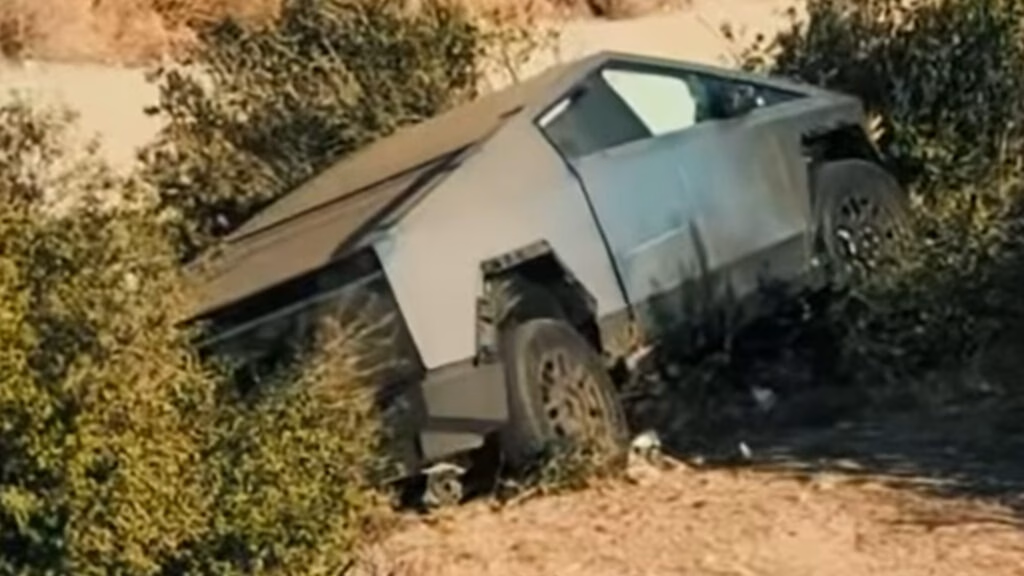What happened when a Tesla Cybertruck went off-road in California?
Early one morning in California’s Cajon Pass, a Tesla Cybertruck found itself in a situation that looked straight out of an action movie—except this was all too real. The electric pickup veered off Interstate 15 around 3:15 a.m., tumbling nearly 600 feet from the roadside into dense shrubbery. By the time the sun rose, the futuristic truck was battered, missing two wheels, and stranded in a ravine.
First responders decided not to attempt a nighttime rescue, prioritizing safety and visibility. Instead, they waited until daylight to reopen the scene. When the time came, local towing company Armada Towing was called in for a job that would test both their patience and their equipment. The Cybertruck’s stainless steel body, usually a point of pride for Tesla, was now a challenge for recovery crews. Heavy-duty straps and a crane arm were needed to hoist the truck over the guardrail and back onto solid ground.
How did the Cybertruck hold up in the crash?
Despite the dramatic tumble, the Cybertruck’s bodywork held up better than you might expect. Sure, two wheels were ripped clean off, and every airbag in the cabin had deployed, but the core structure remained mostly intact. This isn’t just a marketing talking point—modern crash data supports the idea that electric vehicles, thanks to their rigid battery packs and reinforced frames, often fare better in rollovers and high-impact collisions than traditional trucks. According to the Insurance Institute for Highway Safety, EVs tend to have lower injury claims than their gas-powered counterparts, largely due to these structural advantages.
In this case, the driver reportedly managed to escape through the left rear passenger door, which was left ajar after the crash. While there’s no official word on injuries, the ability to walk away from a 600-foot off-road excursion speaks volumes about the vehicle’s safety engineering.
Why did the recovery require a crane, and what does this say about modern EVs?
Pulling a 6,800-pound electric truck out of a ravine isn’t your average tow job. The Cybertruck’s sheer weight—thanks to its battery pack and stainless steel panels—meant that a standard tow truck just wouldn’t cut it. Armada Towing had to get creative, using a crane to gently lift the vehicle over obstacles and back onto the road.
This isn’t just a story about one unlucky driver. As EVs become more common, first responders and tow operators are facing new challenges. Heavier vehicles require specialized equipment, and the risk of battery damage or fire adds another layer of complexity. The National Fire Protection Association has even started offering training specifically for EV incidents, highlighting the need for updated protocols as the auto industry evolves.
What lessons can drivers and emergency crews take from this incident?
For drivers, the message is clear: even the most advanced vehicles have their limits. The Cybertruck’s robust construction may have protected its occupant, but no amount of tech can compensate for the laws of physics when a vehicle leaves the road at speed. Staying alert, especially on winding or poorly lit highways, is as important as ever—no matter what you’re driving.
For emergency crews and tow operators, this crash underscores the importance of ongoing training and investment in heavy-duty recovery gear. As more EVs hit the road, incidents like this will become less of an anomaly and more of a routine challenge. Collaboration between automakers, first responders, and local governments will be key to keeping everyone safe.
Is the Cybertruck’s durability a game-changer or just hype?
The Cybertruck’s resilience in this crash is impressive, but it’s not invincible. The missing wheels and deployed airbags are a reminder that even the toughest vehicles can be sidelined by a serious accident. Still, the fact that the driver was able to exit the vehicle and that the main cabin remained largely intact speaks to the progress automakers have made in EV safety.
Industry experts point out that while the Cybertruck’s design is polarizing, its structural integrity is no joke. The use of ultra-hard stainless steel and a low center of gravity from the battery pack are both factors that contribute to its crashworthiness. However, these same features also make recovery and repair more complicated—and expensive.
What’s the real-world impact for Tesla owners and the industry?
For current and future Tesla owners, this incident is a real-world stress test. It shows that while the Cybertruck can take a beating, repairs after a major crash may be anything but straightforward. Insurance rates for EVs are already higher than average, in part because of the specialized parts and labor required for repairs. According to a 2023 report from the Highway Loss Data Institute, EVs cost about 20% more to fix after a collision than comparable gas vehicles.
For the industry as a whole, this crash is a wake-up call. Automakers, insurers, and emergency services need to keep pace with the rapid evolution of vehicle technology. That means better training, updated equipment, and clear communication with drivers about what to expect in the event of an accident.
The big takeaway? Surviving a crash in a Cybertruck isn’t about perfection—it’s about smarter engineering and adapting to new realities. Whether you’re behind the wheel or working the winch, start with one change this week—maybe it’s a refresher on EV safety, or just a little extra caution on that next late-night drive. You’ll likely spot the difference by month’s end.

